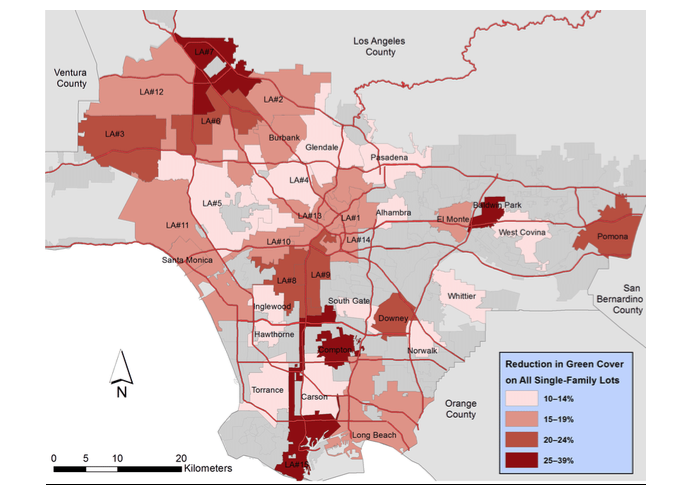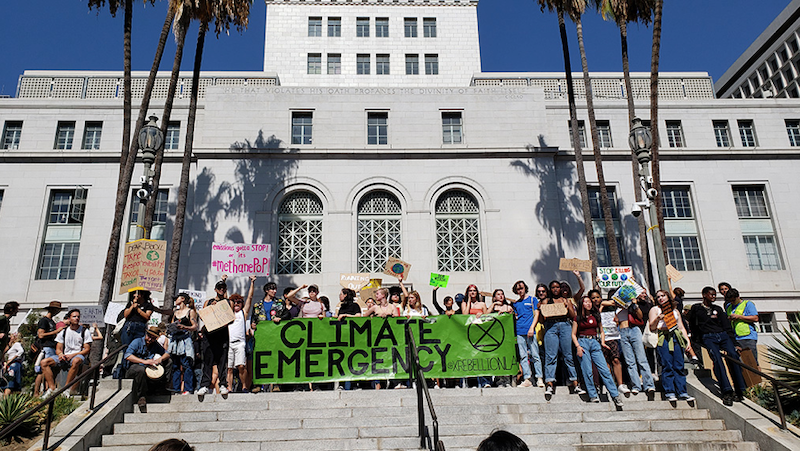CommentsPlanning Watch: As detailed by Samuel Stein in The Real Estate State, the world is awash with massive capital investments in urban real estate.
This is not just a Los Angeles or California phenomena, but extends to the entire planet. According to Professor Stein, “Global real estate is now worth $217 trillion, 36 times the value of all the gold ever mined. It makes up 60 percent of the world’s assets, and the vast majority of that wealth — roughly 75 percent — is in housing.” (Photo above:
Climate emergency rally at LA’s City Hall.)
Los Angeles is a living laboratory for these massive, speculative investments in urban real estate, that some people call Wall Street in My Backyard (WIMBY). Corporate landlords own a surprising amount of housing and empty parcels in LA.
According to a recent draft report, Who’s Buying Los Angeles: How Speculative Finance Keeps Houses Vacant and People Unhoused, commissioned by Strategic Actions for a Just Economy (SAJE) and the Alliance of Californians for Community Empowerment (ACCP), “Los Angeles is increasingly a city that is not owned by people, but by corporate entities of all kinds. 41% of all residential property in the city is directly owned by corporate entities. The same is true for over 22 square miles of vacant lots, a massive amount of land going undeveloped to pad the wallets of corporations and a small class of investors. With only a tiny fraction of people having investments of any kind, this massive concentration of ownership represents a speculative property market set up to make a profit for the few, rather than to the benefit of all . . .”
While previous CityWatchLA columns have explained how speculative investments in expensive housing create high vacancy rates, homelessness, and reduced transit ridership, we also need to understand how this same investment surge fuels the climate crisis.
McMansions, which now number in the many thousands in Los Angeles, aggravate the climate crisis in at least five ways:
- They nullify the embedded carbon in the smaller, older houses that they bulldoze in less than a day, often illegally.
- They promote automobile driving by moving garages from the rear of the lot to the front of the house.
- They turn the permeable soft-scape of the old houses into hard-scape that forces rainwater to drain off the site and into the ocean rather than the ground.
- They de-green Los Angeles by cutting down mature trees to make way for swimming pools, paved patios, mega-houses, and extra-wide driveways. As a result, according to a recent USC study, LA’s tree cover is in free fall because of recent in-fill (i.e., replacement) real estate development.

- Boxy McMansions requires far more energy and water than the homes they replace because the new houses have pools, spas, large appliances, big cars, far more rooms, and heating and air conditioning that blasts 24/7 the entire year.
Real estate speculation undermines cities that respond to the climate crisis through the legally required planning process. Because City Hall’s real estate schemes and scams, like the TOC Guidelines that a civic group, Fix the City, has legally challenged, suck up the building’s oxygen, public officials have little attention left over for research, plans, policies, programs, and monitoring to mitigate climate change. City Hall, its donor class, and their fan base have become so fixated on up-zoning to inflate property values that they have totally by-passed planning, including an essential General Plan Climate Change Element.
Furthermore, when up-zoning results in a local building boom, like LA’s, the new buildings are invariably high-rent apartments. They are not affordable apartment buildings that could partially meet the enormous, pent-up demand in Los Angeles for low income housing. Were the new units and their tenants low income, then transit ridership would rise. This is because these tenants are far more likely to take buses and subways than affluent, car-owning renters in high-priced apartment buildings, even those that happen to be transit-adjacent.
Real estate speculation weakens the California Environmental Quality Act through up-zoning ordinances that allow developers to evade the environment reviews triggered by previously-required discretionary actions, such as zone variances. As a result City Hall routinely approves large, speculative, auto-centric real estate projects without environmental assessments that would calculate their climate impacts.
Furthermore, in the case of the several dozen Los Angeles real estate projects per year that require full Environmental Impact Reports (EIRs), the Los Angeles City Council always adopts a Statement of Overriding Considerations. These actions whisk away EIR findings of each project’s climate impacts. Other options, such as selecting an EIR’s no-project or environmentally superior alternative are never on the table – even though they could substantially reduce a project’s carbon footprint. Why? Because the siren song of speculative real estate investments ensures that City Hall decision makers prioritize real estate profits over actions that could avert a rapidly unfolding climate catastrophe.
Hand writing on the wall: If City Hall officials read the hand writing on the wall about the devastating impacts of climate change on Los Angeles and then responded with policies and program to mitigate climate change, at least three things would change:
- They would stop mansionization and other types of environmentally harmful real estate speculation.
- They would immediately prepare, implement, and monitor a Climate Change Element for LA’s General Plan. It would link up with other adopted plans and policies to promote street tree maintenance and planting, sidewalk and intersection repairs, roof top solar, bicycle infrastructure, and much, much more.
- They would take the California Environmental Quality Act seriously and only approve a project’s most environmentally friendly EIR alternative.
Until this happens, we can expect a compartmentalized approach to climate climate change. Systematic approvals of climate-damaging real estate projects will be paired with photo-ops creating the impression that local officials truly cared about the planet’s future.

Honolulu, Hawaii climate photo-op for big city mayors
(Dick Platkin is a former Los Angeles city planner who reports on local planning issues for CityWatchLA. He serves on the board of United Neighborhoods of Los Angeles (UN4LA) and welcomes comments and corrections at [email protected]. Selected previous columns are available at the CityWatchLA archives and the Plan-it Los Angeles blog.)
-cw
















